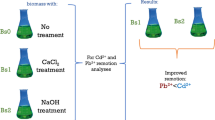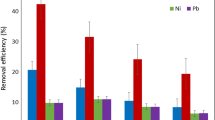Abstract
This study investigated the factors influencing the simultaneous removal of Cd2+, NO3-N and hardness from water by the bacterial strain CN86. Optimum conditions were determined experimentally by varying the type of organic matter used, initial Cd2+ concentration, and pH. Under the optimum conditions, the maximum removal ratios of Cd2+, NO3-N and hardness were 100.00, 89.85 and 71.63%, respectively. The mechanism of Cd2+ removal is a combination of co-precipitation with calcium carbonate and pH. Further confirmation that Cd2+ can be removed by strain CN86 was provided by XRD and XPS analyses. Meteorological chromatography analysis showed that N2 was produced as an end product. These results demonstrate that the bacterial strain CN86 is a suitable candidate for simultaneously removing Cd2+, NO3-N, and hardness during in wastewater treatment.






Similar content being viewed by others
References
Gevorg T, Lilit S, Olga B, Shushanik A, Armen S (2018) Continuous impact of mining activities on soil heavy metals levels and human health. Sci Total Environ 639:900–909
Chen G, Shi L (2017) Removal of Cd (II) and Pb(II) ions from natural water using a low-cost synthetic mineral: behavior and mechanisms. Rsc Adv 7(69):43445–43454
Kermani A, Ghasemi M, Khosravan A, Farahmand A, Shakibaie M (2010) Cadmium bioremediation by metal-resistant mutated bacteria isolated from active sludge of industrial effluent. Iran J Environ Health Sci Eng 7:279–286
Zhao M, Zhang C, Zeng G, Cheng M, Liu Y (2016) A combined biological removal of Cd2+ from aqueous solutions using Phanerochaete chrysosporium and rice straw. Ecotoxicol Environ Saf 130:87–92
Plaza C, Viera M, Donati E (2013) Dynamic cr(iii) uptake by Macrocystis pyrifera and Undaria pinnatifida biomasses. Electron J Biotechn 16(3):1–11
Plaza C, Bernardelli C, Viera M, Donati E, Guibal E (2012) Zinc and cadmium biosorption by untreated and calcium-treated macrocystis pyrifera in a batch system. Bioresour Techol 116:195–203
Pan X, Wang J, Zhang D (2009) Biosorption of strontium ion by immobilized Aspergillus niger. Int J Environ Pollut 37:276–288
Anbu P, Kang C, Shin Y, So J (2016) Formations of calcium carbonate minerals by bacteria and its multiple applications. Springerplus 5(1):1–26
Li W, Chen W, Zhou P, Zhu S, Yu L (2013) Influence of initial calcium ion concentration on the precipitation and crystal morphology of calcium carbonate induced by bacterial carbonic anhydrase. Chem Eng J 218:65–72
Liu W, Yao L, Jiang X, Guo L, Cheng X, Liu G (2017) Sediment denitrification in yangtze lakes is mainly influenced by environmental conditions but not biological communities. Sci Total Environ 616–617:978–987
Chen D, Wang D, Xiao Z, Wang H, Yang K (2018) Nitrate removal in a combined bioelectrochemical and sulfur autotrophic denitrification system under high nitrate concentration: effects of ph. Bioproc Biosyst Eng 41:449–455
Ge Q, Yue X, Wang G (2015) Simultaneous heterotrophic nitrification and aerobic denitrification at high initial phenol concentration by isolated bacterium Diaphorobacter sp. PD-7. Chin J Chem Eng 23:835–841
Ma F, Sun Y, Li A, Zhang X, Yang J (2015) Activation of accumulated nitrite reduction by immobilized Pseudomonas stutzeri T13 during aerobic denitrification. Bioresour Technol 187:30–36
Su J, Liang D, Lian T (2018) Comparison of denitrification performance by bacterium Achromobacter sp. A14 under different electron donor conditions. Chem Eng J 333:320–326
Su J, Ma M, Huang T, Ma F, Shao S, Lu J, Deng L (2017) Characteristics of autotrophic and heterotrophic denitrification by the strain pseudomonas sp. H117. Geomicrobiol J 34(1):45–52
APHA (2005) Standard methods for the examination of water and wastewater, 21st edn. American Public Health Association, Washington, DC
Her J, Huang J (1995) Influences of carbon source and C/N ratio on nitrate/nitrate denitrification and carbon breakthrough. Bioresour Technol 54:45–51
Guo Y, Guo L, Sun M, Zhao Y, Gao M, She Z (2016) Effects of hydraulic retention time (HRT) on denitrification using waste activated sludge thermal hydrolysis liquid and acidogenic liquid as carbon sources. Bioresour Technol 224:147–154
Kim H, Kim J, Shin S, Hwang S, Lee C (2016) Continuous fermentation of food waste leachate for the production of volatile fatty acid and potential as a denitrification carbon source. Bioresour Technol 207:440–445
Li W (2013) Study on characteristics in the removal process of ammonia nitrogen and nitrate nitrogen by an isolated heterotrophic nitrification-aerobic denitrification strain rhodococcus sp. J Environ Prot Ecol 04(1):74–79
Zhang C, Nie S, Liang J, Zeng G, Wu H, Hua S, Liu J, Yuan Y, Xiao H, Deng L, Xian H (2016) Effects of heavy metals and soil physicochemical properties on wetland soil microbial biomass and bacterial community structure. Sci Total Environ 557–558:785–790
Chen Y, Ye W, Yang X, Deng F, He Y (2011) Effect of contact time, pH, and ionic strength on Cd (II) adsorption from aqueous solution onto bentonite from Gaomiaozi, China. Environ Earth Sci 64(2):329–336
Yu R, Shi L, Gu G, Zhou D, You L, Chen M, Qiu G, Zeng W (2014) The shift of microbial community under the adjustment of initial and processing pH during bioleaching of chalcopyrite concentrate by moderate thermophiles. Bioresour Techol 162:300–307
Su J, Gao C, Huang T, Gao Y, Bai X, He L (2019) Characterization and mechanism of the Cd(II) removal by anaerobic denitrification bacterium Pseudomonas sp. H117. Chemosphere 222:970–979
Zhou W, Sun Y, Wu B, Zhang Y, Huang M, Miyanaga T, Zhang Z (2011) Autotrophic denitrification for nitrate and nitrite removal using sulfur-limestone. J Environ Sci China 23(11):1761–1769
Harris W, Wilkie A, Cao X, Sirengo R (2008) Bench-scale recovery of phosphorus from flushed dairy manure wastewater. Bioresour Technol 99(8):3036–3043
Malakootian M, Mansoorian H, Moosazadeh M (2010) Performance evaluation of electrocoagulation process using iron-rod electrodes for removing hardness from drinking water. Desalination 255(1–3):67–71
Kishida N, Kim J, Chen M, Sasaki H, Sudo R (2003) Effectiveness of oxidation-reduction potential and pH as monitoring and control parameters for nitrogen removal in swine wastewater treatment by sequencing batch reactors. J Biosci Bioeng 96(3):285–290
Gal J, Fovet Y, Gache N (2002) Mechanisms of scale formation and carbon dioxide partial pressure influence. Part I. Elaboration of an experimental method and a scaling model. Water Res 36(3):755–763
Gençfuhrman H, Mikkelsen P, Ledin A (2016) Simultaneous removal of as, Cd, Cr, Cu, Ni and Zn from stormwater using high-efficiency industrial sorbents: effect of pH, contact time and humic acid. Sci Total Environ 566–567:76–85
Mwandira W, Nakashima K, Kawasaki S (2017) Bioremediation of lead-contaminated mine waste by Pararhodobacter sp. based on the microbially induced calcium carbonate precipitation technique and its effects on strength of coarse and fine grained sand. Ecol Eng 109:57–64
Achal V, Pan X, Zhang D (2011) Remediation of copper-contaminated soil by Kocuria flava cr1, based on microbially induced calcite precipitation. Ecol Eng 37(10):1601–1605
Kumari D, Pan X, Lee D, Achal V (2014) Immobilization of cadmium in soil by microbially induced carbonate precipitation with Exiguobacterium undae at low temperature. Int Biodeter Biodegr 94:98–102
Itokawa H, Hanaki K, Matsuo T (2001) Nitrous oxide production in high-loading biological nitrogen removal process under low cod/n ratio condition. Water Res 35(3):657–664
Acknowledgements
This research work was partly supported by the National Natural Science Foundation of China (NSFC) (Nos. 51678471, 51778523). Key Scientific Technological Innovation Team Plan of Shaanxi Province (No. 2017KCT-19-02). Key research and development plan of Shaanxi Province (2018ZDXM-SF-029).
Author information
Authors and Affiliations
Corresponding author
Ethics declarations
Conflict of interest
The authors declare that they have no conflict of interest.
Additional information
Publisher's Note
Springer Nature remains neutral with regard to jurisdictional claims in published maps and institutional affiliations.
Rights and permissions
About this article
Cite this article
Su, J.f., Gao, Y.c., Huang, T.l. et al. Simultaneous removal of Cd2+, NO3-N and hardness by the bacterium Acinetobacter sp. CN86 in aerobic conditions. Bioprocess Biosyst Eng 42, 1333–1342 (2019). https://doi.org/10.1007/s00449-019-02132-7
Received:
Accepted:
Published:
Issue Date:
DOI: https://doi.org/10.1007/s00449-019-02132-7




